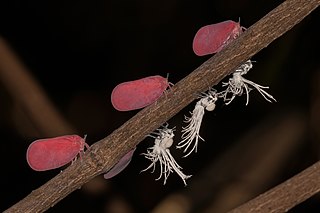
A planthopper is any insect in the infraorder Fulgoromorpha, in the suborder Auchenorrhyncha, a group exceeding 12,500 described species worldwide. The name comes from their remarkable resemblance to leaves and other plants of their environment and that they often "hop" for quick transportation in a similar way to that of grasshoppers. However, planthoppers generally walk very slowly. Distributed worldwide, all members of this group are plant-feeders, though few are considered pests. The infraorder contains only a single superfamily, Fulgoroidea. Fulgoroids are most reliably distinguished from the other Auchenorrhyncha by two features; the bifurcate (Y-shaped) anal vein in the forewing, and the thickened, three-segmented antennae, with a generally round or egg-shaped second segment (pedicel) that bears a fine filamentous arista.

Hausbay is a Verbandsgemeinde in the Rhein-Hunsrück-Kreis district in Rhineland-Palatinate, Germany. It is the location of a large wind farm featuring the world's highest wind energy tower.

Derbidae is a family of insects in the order Hemiptera, the true bugs. It is one of the largest and most diverse families of planthoppers. It is widely distributed around the world, especially in the tropics, and with many species in subtropical and temperate regions.

Lycorma is a genus of planthoppers native to Asia. The first species within the genus was described by Frederick William Hope in 1843 and the genus was formally established by Carl Stål in 1863.

Achilidae is a family of planthoppers, sometimes called "achilids" in the order Hemiptera. There are at least 520 described species in Achilidae.

Aplos is a genus of issid planthopper with only one species, Aplos simplex. It can be found in most of the Eastern United States and is now found as an invasive species in Northern Italy and Austria. Aplos simplex was formerly listed under the genus Thionia.

Acanaloniidae is a family of planthoppers. It is sometimes treated as a subfamily of Issidae.
Paraflata is a genus of planthoppers in the family Flatidae. It was first described by Leopold Melichar in 1901. Species in the genus are found on Madagascar.
Cheiloceps is a genus of planthoppers in the family Issidae. Cheiloceps was described as a genus by Uhler, 1895, downgraded by Fennah, 1955 to a subgenus of Thionia; then restored to genus status by Gnezdilov, 2018.

Fowlerium acutum is a species of planthopper in the family Issidae. They are native to central Texas and Oklahoma.
Amnisa is a genus of issid planthopper in the family Issidae and are native to Brazil.
Dracela is a genus of issid planthopper in the family Issidae and can be found in northern South America and southern Central America.
Oronoqua is a genus of issid planthopper in the family Issidae and can be found in the northern Neotropics. The difference in fore and hind wing venations between species of Oronoqua and the other genera in Thioniini led to a subtribe Oronoquina being erected.
Paranipeus is a genus of issid planthopper containing one species, Paranipeus latipes, native to Brazil.
Proteinissus is a genus of planthopper in the family Issidae, found in Mexico.
Thioniamorpha is a genus of issid planthopper with one species, Thioniamorpha marmorata, found in Panama.
Thioniella is a genus of issid planthopper with one species, Thioniella rugosa, found in Panama.

Fowlerium productum is a species of planthopper in the family Issidae. They are native to the Southwestern United States.

Picumna is a genus of planthopper in the family Issidae. They can be found in the Southwestern United States and Central America. Picumna species are often confused with Thionia species, but can be differentiated as Picumna have four spines on their hind tibia, whereas Thionia have fewer.

Picumna chinai is a species of planthopper in the family Issidae. They can be found across the Southwestern United States and Central America.










